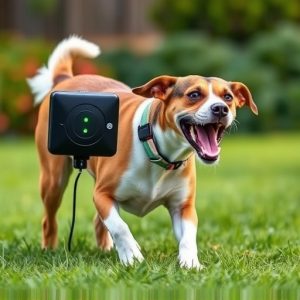Stationary vs Mobile Dog Repellents: Find the Best Solution
The Stationary Vs Mobile Dog Repellent Comparison explores two distinct approaches to dog deterrence…….
The Stationary Vs Mobile Dog Repellent Comparison explores two distinct approaches to dog deterrence. Stationary devices, like motion-activated sprays or electric fences, leverage dogs' aversion to unpleasant sensations for long-term protection in specific areas. Mobile options, including sound or vibration devices, offer versatility and temporary deterrence for dynamic situations like training or outdoor events. Understanding these differences is key to selecting the best solution based on individual needs, ensuring comfort for pets while maintaining human safety.
In many settings, managing dog access is essential for safety and sanitation. Traditional methods often rely on fences or manual intervention, but an evolving solution lies in electronic dog deterrents. This article delves into the world of aggressive dog deterrent systems, exploring two primary types: stationary and mobile. We’ll dissect their functionalities, compare their effectiveness, and guide you through choosing the best solution based on your unique circumstances, offering insights crucial for a Stationary Vs Mobile Dog Repellent Comparison.
- Understanding Dog Behavior: Why Repellents Are Necessary
- The Basics of Stationary Dog Deterrent Systems
- Exploring Mobile Dog Repellent Options
- Comparative Analysis: Effectiveness and Advantages
- Choosing the Right Solution: Factors to Consider for Your Situation
Understanding Dog Behavior: Why Repellents Are Necessary
Dogs, much like humans, have unique personalities and behaviors that can vary greatly from one canine to another. Understanding their behavior is key when it comes to effective deterrence. Dogs are generally territorial creatures, and they communicate through a range of vocalizations, body language, and scent marking. They may display aggression as a defense mechanism to protect their territory, food, or offspring.
In the context of stationary vs. mobile dog repellents, knowing canine behavior is crucial. Mobile repellents, such as those that emit sounds or vibrations, can be effective in deterring dogs by startling them and alerting them to potential danger. On the other hand, stationary devices, like motion-activated sprays or electric fences, rely on the dog’s natural aversion to unpleasant sensations or stimuli. By understanding these behavioral patterns, we can develop tailored solutions that address specific needs, ensuring both canine comfort and human safety.
The Basics of Stationary Dog Deterrent Systems
Dog deterrent systems have evolved significantly, offering both stationary and mobile solutions to address pet behavior issues. When it comes to the basics of stationary dog deterrent systems, these devices are designed for long-term deployment in a specific area. They often use ultrasonic sounds or spray deterrents activated by motion sensors, effectively creating a safe zone without causing harm to the animal. Unlike mobile repellents that rely on movement and proximity, stationary systems remain constant, providing consistent protection for yards, patios, or other outdoor spaces.
In the stationary vs. mobile dog repellent comparison, it’s evident that each has its advantages. Mobile options are ideal for temporary deterrence during specific activities like training or when guests arrive, offering flexibility. On the other hand, stationary systems excel in establishing a permanent barrier against aggressive behavior, making them suitable for households with persistent issues. Understanding these differences is key to choosing the right solution based on individual needs and preferences.
Exploring Mobile Dog Repellent Options
When considering aggressive dog deterrent electronic solutions, it’s crucial to differentiate between stationary and mobile options. While stationary repellents are effective for specific areas like yards or patios, they often require physical installation and may not be easily portable. In contrast, mobile dog repellent options offer versatility, allowing users to move the device as needed, covering larger spaces or different environments. This mobility is particularly beneficial for those who frequently change locations or need a more dynamic approach to deterring aggressive dogs.
The stationary vs. mobile dog repellent comparison highlights a key decision point for pet owners and property managers. Mobile devices can be advantageous in various scenarios, such as outdoor events, temporary dog parks, or during travel when facing new environments. They typically utilize ultrasonic sounds or spray repellents that are safe and humane, emitting high-frequency waves or a mild mist to discourage dogs without causing harm. This flexibility makes mobile options an appealing choice for those seeking a comprehensive yet adaptable solution to manage aggressive canine behavior.
Comparative Analysis: Effectiveness and Advantages
In the realm of dog deterrent electronic solutions, a key consideration revolves around the contrast between stationary and mobile devices. When comparing effectiveness, both types offer unique advantages. Stationary repellents, typically installed in specific areas like fences or gates, excel at providing consistent protection for defined spaces. They are ideal for homeowners seeking reliable barriers against persistent canine intruders.
Conversely, mobile dog repellents offer versatility, allowing users to carry them and adjust their location as needed. These devices prove advantageous in dynamic environments, such as parks or public spaces, where a more fluid approach to deterring dogs is required. In terms of advantages, stationary systems often boast longer-lasting power and more robust construction, making them suitable for prolonged use. Mobile options, however, shine with their convenience, portability, and the ability to target specific, immediate issues without permanent installation.
Choosing the Right Solution: Factors to Consider for Your Situation
When considering an aggressive dog deterrent electronic solution, several factors come into play. One of the primary distinctions to make is between stationary and mobile repellents. Stationary systems are typically installed in specific areas like patios or gardens, emitting a signal that alerts dogs without the need for constant movement. These are ideal for homeowners seeking a reliable, long-term solution for their properties’ perimeter security.
On the other hand, mobile dog repellents offer versatility, as they can be moved and adjusted according to changing needs. This option is perfect for businesses or individuals with dynamic outdoor spaces, frequently modifying layouts, or those who want the flexibility to control the repellent’s range and intensity on-the-go. The choice between stationary and mobile depends on your specific situation, desired level of control, and the size of the area you wish to protect.
When selecting an aggressive dog deterrent electronic solution, understanding both stationary and mobile options is key. A stationary dog repellent offers consistent protection for specific areas, while mobile options provide flexibility for larger, dynamic spaces. Comparing their effectiveness and advantages can help you choose the right solution for your unique situation. Remember, the best deterrent considers both dog behavior and your environment to ensure a safe, harmonious coexistence with our furry neighbors. In terms of stationary vs mobile dog repellent comparison, understanding these options will lead to a more effective and humane choice.


